Items
Tag
mountains
-
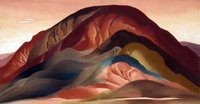 Rust Red Hills Born in 1887, Georgia O'Keeffe was an American artist who painted nature in a way that showed how it made her feel. She is best known for her paintings of flowers and desert landscapes. She played an important part in the development of modern art in America, becoming the first female painter to gain respect in New York's art world in the 1920s. Her unique and new way of painting nature, simplifying its shapes and forms meant that she was called a pioneer.
Rust Red Hills Born in 1887, Georgia O'Keeffe was an American artist who painted nature in a way that showed how it made her feel. She is best known for her paintings of flowers and desert landscapes. She played an important part in the development of modern art in America, becoming the first female painter to gain respect in New York's art world in the 1920s. Her unique and new way of painting nature, simplifying its shapes and forms meant that she was called a pioneer. -
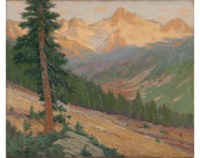 Autumn Afternoon, Rocky Mountains
Autumn Afternoon, Rocky Mountains
-
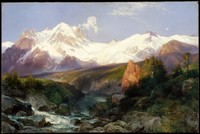 The Teton Range As Albert Bierstadt claimed the Rocky Mountains and the Sierra Nevada for his art, so Moran made the Yellowstone region and the Grand Canyon his signature subjects. His dazzling paintings and illustrations of Yellowstone led directly to its designation in 1872 as the first national park. A native Briton and an ardent admirer of the English painter J. M. W. Turner, Moran orchestrated dynamic form and prismatic color into visual anthems to America’s scenic splendors—such as this dramatic view of the Tetons, located just south of Yellowstone and characterized by one of the country’s most picturesque mountain profiles.
The Teton Range As Albert Bierstadt claimed the Rocky Mountains and the Sierra Nevada for his art, so Moran made the Yellowstone region and the Grand Canyon his signature subjects. His dazzling paintings and illustrations of Yellowstone led directly to its designation in 1872 as the first national park. A native Briton and an ardent admirer of the English painter J. M. W. Turner, Moran orchestrated dynamic form and prismatic color into visual anthems to America’s scenic splendors—such as this dramatic view of the Tetons, located just south of Yellowstone and characterized by one of the country’s most picturesque mountain profiles. -
 Mount Brewer
Mount Brewer
-
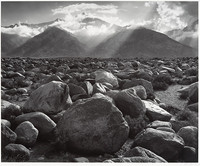 Mount Williamson, Sierra Nevada, from Manzanar, California
Mount Williamson, Sierra Nevada, from Manzanar, California
-
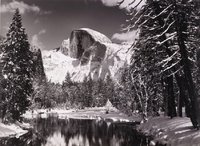 Winter, Yosemite Valley
Winter, Yosemite Valley
-
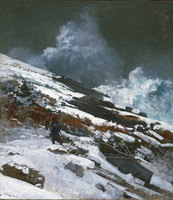 Winter Coast Homer’s tiny hunter, carrying a goose on his back, is dwarfed by the massive shelving rocks and pounding surf of Prout’s Neck, Maine. Like the increasingly solitary artist, the human figure appears alone, hardy, and ephemeral.
Winter Coast Homer’s tiny hunter, carrying a goose on his back, is dwarfed by the massive shelving rocks and pounding surf of Prout’s Neck, Maine. Like the increasingly solitary artist, the human figure appears alone, hardy, and ephemeral. -
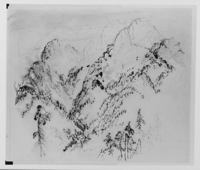 Cascade Mountain Landscape
Cascade Mountain Landscape
-
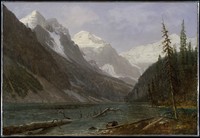 Canadian Rockies (Lake Louise) During his travels in the American and Canadian West, Bierstadt made oil sketches such as this one, which he used, back in his New York studio, for reference in concocting the huge, carefully detailed panoramic scenes that brought him critical acclaim during the 1860s and 1870s. By the end of the century, American viewers had come to appreciate the more modest landscape observations of Barbizon and Impressionist painters, and Bierstadt’s sketches were themselves valued as fresh, direct records of the places he had visited.
Canadian Rockies (Lake Louise) During his travels in the American and Canadian West, Bierstadt made oil sketches such as this one, which he used, back in his New York studio, for reference in concocting the huge, carefully detailed panoramic scenes that brought him critical acclaim during the 1860s and 1870s. By the end of the century, American viewers had come to appreciate the more modest landscape observations of Barbizon and Impressionist painters, and Bierstadt’s sketches were themselves valued as fresh, direct records of the places he had visited. -
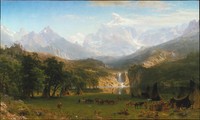 The Rocky Mountains, Lander's Peak This painting is the major work that resulted from the artist's first trip to the West. His intention to create panoramic views of the American frontier was apparent by December 1858, just before he embarked on the trip. In early 1859 he accompanied a government survey expedition, headed by Frederick W. Lander, to the Nebraska Territory. By summer, the party had reached the Wind River Range of the Rocky Mountains in what is now Wyoming. Bierstadt dubbed the central mountain in the picture Lander's Peak following the colonel's death in the Civil War. This was one of a number of large works painted after Bierstadt's return from these travels. It was completed in 1863, exhibited to great acclaim, and purchased in 1865 for the then-astounding sum of $25,000 by James McHenry, an American living in London. Bierstadt later bought it back and gave or sold it to his brother Edward.
The Rocky Mountains, Lander's Peak This painting is the major work that resulted from the artist's first trip to the West. His intention to create panoramic views of the American frontier was apparent by December 1858, just before he embarked on the trip. In early 1859 he accompanied a government survey expedition, headed by Frederick W. Lander, to the Nebraska Territory. By summer, the party had reached the Wind River Range of the Rocky Mountains in what is now Wyoming. Bierstadt dubbed the central mountain in the picture Lander's Peak following the colonel's death in the Civil War. This was one of a number of large works painted after Bierstadt's return from these travels. It was completed in 1863, exhibited to great acclaim, and purchased in 1865 for the then-astounding sum of $25,000 by James McHenry, an American living in London. Bierstadt later bought it back and gave or sold it to his brother Edward. -
 Heart of the Andes This picture was inspired by Church's second trip to South America in the spring of 1857. Church sketched prolifically throughout his nine weeks travel in Ecuador, and many extant watercolors and drawings contain elements found in this work. The picture was publicly unveiled in New York at Lyrique Hall, 756 Broadway, on April 27, 1859. Subsequently moved to the gallery of the Tenth Street Studio Building, it was lit by gas jets concealed behind silver reflectors in a darkened chamber. The work caused a sensation, and twelve to thirteen thousand people paid twenty-five cents apiece to file by it each month. The picture was also shown in London, where it was greatly admired as well.
Heart of the Andes This picture was inspired by Church's second trip to South America in the spring of 1857. Church sketched prolifically throughout his nine weeks travel in Ecuador, and many extant watercolors and drawings contain elements found in this work. The picture was publicly unveiled in New York at Lyrique Hall, 756 Broadway, on April 27, 1859. Subsequently moved to the gallery of the Tenth Street Studio Building, it was lit by gas jets concealed behind silver reflectors in a darkened chamber. The work caused a sensation, and twelve to thirteen thousand people paid twenty-five cents apiece to file by it each month. The picture was also shown in London, where it was greatly admired as well.